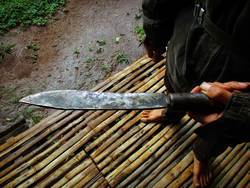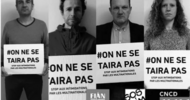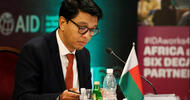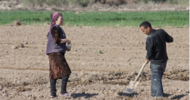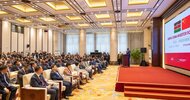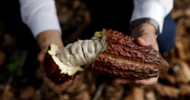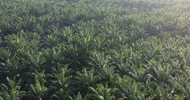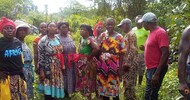Southeast Asia Globe | 29 August 2019
Uprooted
Landgrabs, deforestation and an increasingly-globalised Khmer culture are encroaching deep into the lands and lore of Cambodia's indigenous Bunong people
Tabitha Payne
Speaking over the not-so-distant hum of chainsaws in Keo Seima Wildlife Sanctuary, Briv*, an indigenous Bunong forest guide at Jahoo Gibbon Camp, admits that he would prefer that schools teach in both Khmer and Bunong. According to World Hope International (WHI), an international NGO doing community development work in Andong Kralong, a majority Bunong village by Jahoo Gibbon Camp, it is difficult for minorities to find public education in their own languages. This in turn makes learning an uphill battle for Bunong children who may have never spoken Khmer in their life – a marginalisation experienced by many ethnic minorities across Southeast Asia.
Briv values Khmer as “the language of the law”. Often caught up in land disputes over forested ancestral lands, the Bunong must know the law in order to protect the forest and their culture.
But, he adds, “Bunong culture is the law to protect the forest.”
This past week, images of the fires ravaging the Amazon to clear land for cultivation have shocked the international public. But for the Bunong, over the last 40 years, a less publicised blaze has been eating away at the jungles in which they had lived for an estimated two thousand years.
In 1973, 13.1 million hectares of forest blanketed Cambodia. By 2014, this had dropped to 8.7 million – marking the first time Cambodia had less forest cover than non-forest cover in that period, according to Open Development Cambodia (ODC), a Southeast Asia-based online open data source, using information from the Cambodian Department of Forestry Administration and analysis by a mapping team. According to 2017 NASA satellite imagery, only 3% of Cambodia’s primary forest still stands.
A voracious hunger for land and precious timber has gobbled up over half of Cambodia’s dense woodland, leaving the country the ninth most deforested in the world, going by an index drawn up by Maplecroft, a UK-based global risk and strategic consulting firm.
Since 2001, the Cambodian government has granted at least a million hectares of land to foreign investors and elites through its controversial scheme of Economic Land Concessions (ELCs). According to a 2015 report by Forest Trends, a Washington DC-based international NGO that works towards conservation through environmental finance, 80% of this leased land falls within the boundaries of protected forest, but those protections do not hinder agro-businesses from clearing thousands of hectares of forest. When this land is already occupied by local communities, disputes quickly flare up.
Three forest rangers were killed in Mondulkiri early last year in a showdown with loggers near the Vietnam border.
One of the three was a young Bunong man with two young children. For Briv, another forest guide, his young counterpart’s untimely death defending the very forest to which Bunong identity is inextricably linked highlights how logging is literally putting his people’s survival at risk.
The Bunong have found themselves at the crossroads of intense international interest in such natural resources – cornering them into bargaining just to remain on land they have lived on for millennia.
“If there is no forest,” says Briv, “there are no more Bunong.” He predicts the forest will be gone in a century – suggesting a precarious future for his people.
“If we are strong enough we can try to defend ourselves,” says Mane Yun, a human rights activist who in 2001 became the first Bunong to earn a Bachelor’s degree in law. “But some communities are not agreeing with each other.”
She likens the situation to a dam with too much water. “It came too quickly,” she says. For Yun, it is as if the Bunong had no “anti-viral” to protect themselves.
“There is very limited support from the government,” she says. “There are development partners, communities, activists, but it seems like we don’t have enough energy and power. Affecting everything is land and resource loss. This affects cultural identity and livelihood.”
The Bunong, also known as the Phnong, number approximately 50,000 and represent the largest indigenous group living in Cambodia’s northeastern Mondulkiri province. Their culture is based on an interdependent relationship with the forest, as seen in their belief that objects in nature – mountains, water, animals and of course forests – all carry spirits that retaliate when disrespected, even bringing illness and other misfortunes to communities.
The Bunong belief system decrees that certain sacred pockets of wilderness, called spirit forests, must never be cut. The lives of animals such as elephants and gibbons are seen as equal to those of humans – they must never be hunted or eaten.
But the traditional Bunong way of life runs contrary to the law of the land in modern Cambodia. A number of their practices – such as hunting animals, and their traditional rotational swidden agriculture that relies on limited slash and burn practices – have been outlawed, the latter replaced by cash crops. Their best-known custom, the domestication of elephants, is not only illegal but impractical – there just aren’t enough wild elephants left to capture.
For better or worse, the introduction of the Cambodian legal system has complicated the Bunong’s ancient system of self-government in which elders solve community disputes internally.
Despite the Bunong living in Mondulkiri for what historians believe to be two millennia, the question of who owns their ancestral land is still highly contested. Bunong tradition holds that the forest is owned by everyone. Nowadays, however, they have to contend with the concept of private land ownership. Some communities have succeeded in acquiring communal land titles to protect against land-grabbing from the state and international companies, a problem that human rights NGO Licadho in 2012 estimated had affected 420,000 Cambodians since 2003. But this arduous process of formalising collective land ownership can take many years and is rife with legal hurdles.
Before and after
“Before the Khmer Rouge, in my village, nobody spoke Khmer,” says Lorang*, a 58-year old survivor of the regime’s depredations.
“My parents wore Bunong traditional clothes, but I and other young people wore a mix.”
Khmer Rouge militias first came into Lorang’s village in 1971 or 1972, after US bombing had ravaged the province and driven many from their homes – a time which, according to Briv, the Bunong recall as “boom”.
“In 1975, all the people from my area moved to live in Koh Nhek district,” he says. “Different minorities – Bunong, Jarai, Kurung – were together.” There, Lorang claims, they worked as labourers in communes, speaking a mix of languages.
Before the Vietnam War, a million indigenous people inhabited the highlands of Cambodia, Vietnam, and Laos. By the time the Khmer Rouge was ousted, at least half the adult male population had died.
“Some Khmer people think the Khmer Rouge only affected the Khmer,” says Sreyneang Loek, a young Bunong graduate in Phnom Penh, “but indigenous people were affected too.”
“Afterwards, our people still followed the culture,” says Lorang. “But some of the materials were lost.”
Among the vestiges of Bunong culture that were almost lost to the Khmer Rouge included their revered elephants.
“After the Khmer Rouge, the elephants were gone,” he continues. The Khmer Rouge took away the elephant shared by his family and many others. He never found out where it went, and after the war, he moved to a new village in search of a livelihood, finding trees with resin he could sell.
Few domesticated elephants remain in Mondulkiri. Jemma Bullock is programme manager of Elephant Livelihood Initiative Environment at Elephant Valley Project, an elephant sanctuary NGO in Mondulkiri. It is here that Bunong and Khmer mahouts raise the last generation of Cambodia’s domesticated elephants – ten of the 36 remaining in the province at the EVP sanctuary.
While before the war, Jemma estimates, most Bunong communities kept about 20 elephants each, the conflict wrought a terrible toll: some elephants were killed and eaten, some worked to death. Others escaped into the forest, with only a handful ever found again.
But some continued to cherish the creatures, despite the dangers. “During the civil war some Bunong people managed to survived the war by hiding in the forest with their elephants,” she says.
In Lorang’s view, before the Khmer Rouge, people still “fully respected” Bunong culture.
“All people wanted to learn and practice… Today, it’s very changed,” she says.
But the historic record contradicts this idyllic vision of the past: the Bunong had been struggling with meddling outsiders for decades.
During the colonial era, Bunong resistance against the French, who were forcing Bunong men to build a major road and other infrastructure projects, earned them a reputation as fierce warriors. During his reign, Prince Norodom Sihanouk took it upon himself to attempt a perceived modernisation of Cambodia’s indigenous peoples, who he named the “Khmer Loeu” or “Upper Khmer.”
His “Khmerisation” campaign urged indigenous people to move closer to the French road and live like Khmer people – even going so far as distributing Khmer traditional cloth to locals.
Many Khmer words have been injected into colloquial Bunong – such as “rean” (to study), “prochum” (meeting), or “sala” (school) – leading Briv to worry his great-grandchildren will not know how to speak Bunong.
Missionaries adapted the Bunong language to Khmer script, but some Bunong, like Briv, do not know how to use this Khmer-style written version of Bunong. He and his friends text one another in Khmer.
This century of cultural overhaul has undermined traditional notions of Bunong identity, opening an enormous generation gap between elders and youth, the latter blamed by older Bunong for the crisis facing Bunong culture.
“Young people don’t try to learn,” says Lorang, who tries to teach them traditional basket weaving. “They don’t know how to talk to the spirits. They don’t know where the spirits live.”
“Young people focus on materialism,” says Briv. “They don’t really care about existing resources.”
To him, if young people would collect medicine in the forest like their ancestors, that would help protect the forest. Instead, he says, they take up illegal logging to buy the “material things they are chasing”.
Left behind
“Currently, young people can’t make rice wine,” Briv claims about the traditional Bunong iteration of the drink. “They don’t know the recipe.”
Although the internal criticisms of Bunong youth sound typical of any community – partying, drugs, a lack of respect for elders – their actions, given the threat the Bunong community faces, are read as “leaving their culture behind”.
The expectations that Bunong youth should support their families financially weighs heavily, with many of the young compelled to leave home due to a dearth of job and educational opportunities. In turn, pressure grows on the Bunong to assimilate to Khmer culture as economic interdependence increases.
But when confronted by the sometimes conflicting strains of overcoming poverty versus passing the cultural torch, many will put the former first.
An ongoing multimillion dollar illegal rosewood logging industry and lucrative wildlife trade has led many to turn to illegal logging and poaching.
But the work is dangerous and costly. People can get hurt or caught by police, and the work smacks more of desperation rather than a chance to get rich.
In a 2018 report by the School of Field Studies, an environmental international research programme, Bunong interviewees complained that police targeted their small-scale cutting but left the logging operations of “rich people” alone. Many reported feelings of helplessness, with half the respondents saying “If I don’t cut the trees in the forest, others will.”
“There is more business for us because of illegal logging,” says one youth quoted in the study. “But this business is good for rich people and bad for us. We cut trees to fulfill life necessities.”
“Only men go and cut the forest,” says Payat*, a 23-year old Bunong woman in Andong Kralong. “They do it for livelihoods and to support their families.” For her, the community’s own tree-cutting practices are sustainable.
“If we just cut for buildings, it’s okay,” agrees Lorang.
But young loggers drive in and out of the protected forest towing more logs than are needed for just house-building. The men, or more often teenage boys, hide their faces as they skid down slippery mud roads on motorbikes gutted to bear as much weight as possible.
Andong Kralong has been transformed in recent years. Kyle Winney, a conservationist with WHI who did environmental research in the village a decade ago, does not remember the houses as large and high-quality. The improvements go beyond logging for sustenance, and the culprit, he believes, is almost certainly logging money.
Yun, the activist, acknowledges the unsustainable actions of indigenous people but ultimately views these as livelihood issues. For her, the real problem is “not because of them, but because of globalisation”.
“The development plans of the government in terms of economy” and the “demand to fulfil the needs of a growing population” leads to an issue of “land and natural resource management,” she says.
Specifically, Yun says, “the development problem is mining companies and social land concessions”, or SLCs. By the latter, she is referring to a government programme where land is granted to the landless poor. However, many indigenous people from Mondulkiri, activists, and land rights groups are critical of SLCs, claiming the government has given away already-occupied land and is furthering forest loss through this re-categorisation of territory.
“The concessions of Chinese, Vietnamese, and European companies make a lot of challenges and problems,” Yun says.
“The challenge is bigger than the resources you’re trying to protect.”
A 2012 ODC dataset charts 34 different ELCs in Mondulkiri, ranging from 500 to 9,773 hectares in size for leases up to 70 years. The majority are for agro-industries. Developers hail from Cambodia, China, Vietnam, Malaysia, and France. Some ELCs lie on ancestral lands.
One such case is Socfin-KCD, a 2,386 hectare French rubber plantation operating in Mondulkiri since 2008 with a 70-year lease. According to Cambodian Centre for Human Rights (CCHR), a human rights organisation, the ELC affected over 800 families, the majority of them Bunong. Mondulkiri officials allege the dispute is settled. The villagers claim the lawsuits continue.
“When you look at the law, it’s good at protecting indigenous people’s rights,” says Yun. “It’s good at protecting the forest. But in reality, it’s only the law. When communities use the law to protect themselves, they are made to look like villains themselves.”
The spirits are angry
Payat believes that deforestation is causing climate change. For her, it has to do with water and forest spirits, something echoed in the SFS report, which found that many Bunong viewed themselves as “protectors of the forest and therefore spirits are angry at them for deforestation.”
“When all the resources are gone, their spirits will be gone as well,” says Briv, referring to his prediction that the forest will be no more, a century from now.
“Bunong is human the same as other countries,” says Briv, “If you kill our culture, it is like killing your culture the same.”
Briv compares his people’s experience to that of the southern yellow-cheeked crested gibbon, an endangered primate. Unlike the Duc Langur, a monkey that will flee to other forest when its territory is cleared, the gibbon will die with the jungle it was born in.
Sylvain Vogel, a linguist who lived with the Bunong for many years, echoed Briv’s ominous prediction. In 2018 he told The Diplomat, an Asia Pacific-focused magazine and website, that he saw little hope for the Bunong.
“I offer no solutions,” he said. “No wishful thinking, no politically correct language, or bleeding hearts can change a thing. I was only a witness who watched, with great sadness and a feeling of helplessness, the disappearance of a culture.”
While such predictions may sound premature, last year’s legal dissolution of the Snoul Wildlife Sanctuary to the south suggests that an unsettling precedent can be set by forest loss. Because the forest was erased, the state could no longer list the location as a sanctuary.
But not all Bunong are pessimistic: neither Lorang or Payat think the forest will disappear. Others do not see the future of the Bunong as tied to the forest. Instead, they look to education and activism as paths for Bunong culture to adapt to a globalising Cambodia, with Yun and Loek personifying this worldview as trilingual law graduates working as activists for their communities.
“People complain that when young people get educated in Phnom Penh, they lose their identity,” says Yun, one of the founders of Cambodia Indigenous People’s Association (CIYA), an activist group in the capital. “But it’s not that simple. For example, some wear our indigenous clothes to school and work in Phnom Penh.”
“Now a lot of the young generation is starting to be interested in their culture, but they are in Phnom Penh.”
To feed this revived interest, and to rebut what she described as Khmer derision about Bunong food, Yun opened indigenous peoples’ restaurants in Sen Monorom and Phnom Penh in 2011 – “the best she can do” for Bunong culture, she says.
“It’s more social work than business,” she says, listing her aims as “to preserve and protect cultural identity” and to “awaken indigenous people.”
“Living here, many of us become activists,” Loek says, echoing Yun’s determination to counter derogatory Khmer claims about Bunong culture.
“We raise our voice to be heard by the state,” she says, acknowledging that the big city offers opportunities to young Bunong, who are “able to learn English, learn how people in the city live, learn how to know about the issues of country”.
Bunong in Phnom Penh can also find out more about how their people relate “around the world to other indigenous people,” she says. And Loek is concerned about the “huge impact to indigenous people and culture” deforestation is having.
“As we live depends on the forest,” she says. “Our culture is connected.” In her view, forest loss has particular impact on women and children. “In our culture, women are the people who carry on traditional livelihoods.”
Losing forest means losing medicinal plants – and this affects children’s well-being. “Health, mental issues, physical problems,” she says, ”are all tied to deforestation.”
“There are 370 million indigenous people around the world. Half are affected by this issue.”
For Loek, the Bunong cannot depend on the forest for a sustainable future. “People are moving forward,” she says. “People are developing. This impacts youth. We are thinking about the future. We can’t stick to traditional livelihoods.”
At the same time, these realities do not mean Bunong identity should fade away, with Loek adamant that “we cannot abandon our culture.”
“If people get educated, our culture will be protected,” she says, eschewing Briv’s fatalism. “We are not going to depend on the forest but education. But we have to have a shared idea of conservation.”
Loek hopes some Bunong can become anthropologists, doctors and lawyers before returning to help preserve their culture. She wants that Bunong girls “have more opportunity to study, to be a lawyer, lecturer, a star, if they want to.”
“They can have more opportunity than me,” she says. Her optimism is cautious but based on evidence of change – she cites the fact that several Bunong have found positions in provincial government.
Loek sees the Bunong as having the same capacity to develop as any other culture.
In Andong Kralong primary school, Bunong teachers and parents have collaborated on strengthening Bunong language and culture in children from early years – as well as a food programme.
WHI reports show a 24% increase in enrollment over 2016-2017, with provincial test scores up from among the lowest to among the highest.
“My message,” says Loek, “[is] nobody can help us besides ourselves. We are the only ones to be documenters.”
But neither Loek nor Yun think indigenous people should be solely responsible for protecting forests. “I don’t think it matters if you’re non-indigenous,” says Yun. “If you want to support – we need support.”
*pseudonyms used at request of interviewees
Uprooted
Landgrabs, deforestation and an increasingly-globalised Khmer culture are encroaching deep into the lands and lore of Cambodia's indigenous Bunong people
Tabitha Payne
Speaking over the not-so-distant hum of chainsaws in Keo Seima Wildlife Sanctuary, Briv*, an indigenous Bunong forest guide at Jahoo Gibbon Camp, admits that he would prefer that schools teach in both Khmer and Bunong. According to World Hope International (WHI), an international NGO doing community development work in Andong Kralong, a majority Bunong village by Jahoo Gibbon Camp, it is difficult for minorities to find public education in their own languages. This in turn makes learning an uphill battle for Bunong children who may have never spoken Khmer in their life – a marginalisation experienced by many ethnic minorities across Southeast Asia.
Briv values Khmer as “the language of the law”. Often caught up in land disputes over forested ancestral lands, the Bunong must know the law in order to protect the forest and their culture.
But, he adds, “Bunong culture is the law to protect the forest.”
This past week, images of the fires ravaging the Amazon to clear land for cultivation have shocked the international public. But for the Bunong, over the last 40 years, a less publicised blaze has been eating away at the jungles in which they had lived for an estimated two thousand years.
In 1973, 13.1 million hectares of forest blanketed Cambodia. By 2014, this had dropped to 8.7 million – marking the first time Cambodia had less forest cover than non-forest cover in that period, according to Open Development Cambodia (ODC), a Southeast Asia-based online open data source, using information from the Cambodian Department of Forestry Administration and analysis by a mapping team. According to 2017 NASA satellite imagery, only 3% of Cambodia’s primary forest still stands.
A voracious hunger for land and precious timber has gobbled up over half of Cambodia’s dense woodland, leaving the country the ninth most deforested in the world, going by an index drawn up by Maplecroft, a UK-based global risk and strategic consulting firm.
Since 2001, the Cambodian government has granted at least a million hectares of land to foreign investors and elites through its controversial scheme of Economic Land Concessions (ELCs). According to a 2015 report by Forest Trends, a Washington DC-based international NGO that works towards conservation through environmental finance, 80% of this leased land falls within the boundaries of protected forest, but those protections do not hinder agro-businesses from clearing thousands of hectares of forest. When this land is already occupied by local communities, disputes quickly flare up.
Three forest rangers were killed in Mondulkiri early last year in a showdown with loggers near the Vietnam border.
One of the three was a young Bunong man with two young children. For Briv, another forest guide, his young counterpart’s untimely death defending the very forest to which Bunong identity is inextricably linked highlights how logging is literally putting his people’s survival at risk.
The Bunong have found themselves at the crossroads of intense international interest in such natural resources – cornering them into bargaining just to remain on land they have lived on for millennia.
“If there is no forest,” says Briv, “there are no more Bunong.” He predicts the forest will be gone in a century – suggesting a precarious future for his people.
“If we are strong enough we can try to defend ourselves,” says Mane Yun, a human rights activist who in 2001 became the first Bunong to earn a Bachelor’s degree in law. “But some communities are not agreeing with each other.”
She likens the situation to a dam with too much water. “It came too quickly,” she says. For Yun, it is as if the Bunong had no “anti-viral” to protect themselves.
“There is very limited support from the government,” she says. “There are development partners, communities, activists, but it seems like we don’t have enough energy and power. Affecting everything is land and resource loss. This affects cultural identity and livelihood.”
The Bunong, also known as the Phnong, number approximately 50,000 and represent the largest indigenous group living in Cambodia’s northeastern Mondulkiri province. Their culture is based on an interdependent relationship with the forest, as seen in their belief that objects in nature – mountains, water, animals and of course forests – all carry spirits that retaliate when disrespected, even bringing illness and other misfortunes to communities.
The Bunong belief system decrees that certain sacred pockets of wilderness, called spirit forests, must never be cut. The lives of animals such as elephants and gibbons are seen as equal to those of humans – they must never be hunted or eaten.
But the traditional Bunong way of life runs contrary to the law of the land in modern Cambodia. A number of their practices – such as hunting animals, and their traditional rotational swidden agriculture that relies on limited slash and burn practices – have been outlawed, the latter replaced by cash crops. Their best-known custom, the domestication of elephants, is not only illegal but impractical – there just aren’t enough wild elephants left to capture.
For better or worse, the introduction of the Cambodian legal system has complicated the Bunong’s ancient system of self-government in which elders solve community disputes internally.
Despite the Bunong living in Mondulkiri for what historians believe to be two millennia, the question of who owns their ancestral land is still highly contested. Bunong tradition holds that the forest is owned by everyone. Nowadays, however, they have to contend with the concept of private land ownership. Some communities have succeeded in acquiring communal land titles to protect against land-grabbing from the state and international companies, a problem that human rights NGO Licadho in 2012 estimated had affected 420,000 Cambodians since 2003. But this arduous process of formalising collective land ownership can take many years and is rife with legal hurdles.
Before and after
“Before the Khmer Rouge, in my village, nobody spoke Khmer,” says Lorang*, a 58-year old survivor of the regime’s depredations.
“My parents wore Bunong traditional clothes, but I and other young people wore a mix.”
Khmer Rouge militias first came into Lorang’s village in 1971 or 1972, after US bombing had ravaged the province and driven many from their homes – a time which, according to Briv, the Bunong recall as “boom”.
“In 1975, all the people from my area moved to live in Koh Nhek district,” he says. “Different minorities – Bunong, Jarai, Kurung – were together.” There, Lorang claims, they worked as labourers in communes, speaking a mix of languages.
Before the Vietnam War, a million indigenous people inhabited the highlands of Cambodia, Vietnam, and Laos. By the time the Khmer Rouge was ousted, at least half the adult male population had died.
“Some Khmer people think the Khmer Rouge only affected the Khmer,” says Sreyneang Loek, a young Bunong graduate in Phnom Penh, “but indigenous people were affected too.”
“Afterwards, our people still followed the culture,” says Lorang. “But some of the materials were lost.”
Among the vestiges of Bunong culture that were almost lost to the Khmer Rouge included their revered elephants.
“After the Khmer Rouge, the elephants were gone,” he continues. The Khmer Rouge took away the elephant shared by his family and many others. He never found out where it went, and after the war, he moved to a new village in search of a livelihood, finding trees with resin he could sell.
Few domesticated elephants remain in Mondulkiri. Jemma Bullock is programme manager of Elephant Livelihood Initiative Environment at Elephant Valley Project, an elephant sanctuary NGO in Mondulkiri. It is here that Bunong and Khmer mahouts raise the last generation of Cambodia’s domesticated elephants – ten of the 36 remaining in the province at the EVP sanctuary.
While before the war, Jemma estimates, most Bunong communities kept about 20 elephants each, the conflict wrought a terrible toll: some elephants were killed and eaten, some worked to death. Others escaped into the forest, with only a handful ever found again.
But some continued to cherish the creatures, despite the dangers. “During the civil war some Bunong people managed to survived the war by hiding in the forest with their elephants,” she says.
In Lorang’s view, before the Khmer Rouge, people still “fully respected” Bunong culture.
“All people wanted to learn and practice… Today, it’s very changed,” she says.
But the historic record contradicts this idyllic vision of the past: the Bunong had been struggling with meddling outsiders for decades.
During the colonial era, Bunong resistance against the French, who were forcing Bunong men to build a major road and other infrastructure projects, earned them a reputation as fierce warriors. During his reign, Prince Norodom Sihanouk took it upon himself to attempt a perceived modernisation of Cambodia’s indigenous peoples, who he named the “Khmer Loeu” or “Upper Khmer.”
His “Khmerisation” campaign urged indigenous people to move closer to the French road and live like Khmer people – even going so far as distributing Khmer traditional cloth to locals.
Many Khmer words have been injected into colloquial Bunong – such as “rean” (to study), “prochum” (meeting), or “sala” (school) – leading Briv to worry his great-grandchildren will not know how to speak Bunong.
Missionaries adapted the Bunong language to Khmer script, but some Bunong, like Briv, do not know how to use this Khmer-style written version of Bunong. He and his friends text one another in Khmer.
This century of cultural overhaul has undermined traditional notions of Bunong identity, opening an enormous generation gap between elders and youth, the latter blamed by older Bunong for the crisis facing Bunong culture.
“Young people don’t try to learn,” says Lorang, who tries to teach them traditional basket weaving. “They don’t know how to talk to the spirits. They don’t know where the spirits live.”
“Young people focus on materialism,” says Briv. “They don’t really care about existing resources.”
To him, if young people would collect medicine in the forest like their ancestors, that would help protect the forest. Instead, he says, they take up illegal logging to buy the “material things they are chasing”.
Left behind
“Currently, young people can’t make rice wine,” Briv claims about the traditional Bunong iteration of the drink. “They don’t know the recipe.”
Although the internal criticisms of Bunong youth sound typical of any community – partying, drugs, a lack of respect for elders – their actions, given the threat the Bunong community faces, are read as “leaving their culture behind”.
The expectations that Bunong youth should support their families financially weighs heavily, with many of the young compelled to leave home due to a dearth of job and educational opportunities. In turn, pressure grows on the Bunong to assimilate to Khmer culture as economic interdependence increases.
But when confronted by the sometimes conflicting strains of overcoming poverty versus passing the cultural torch, many will put the former first.
An ongoing multimillion dollar illegal rosewood logging industry and lucrative wildlife trade has led many to turn to illegal logging and poaching.
But the work is dangerous and costly. People can get hurt or caught by police, and the work smacks more of desperation rather than a chance to get rich.
In a 2018 report by the School of Field Studies, an environmental international research programme, Bunong interviewees complained that police targeted their small-scale cutting but left the logging operations of “rich people” alone. Many reported feelings of helplessness, with half the respondents saying “If I don’t cut the trees in the forest, others will.”
“There is more business for us because of illegal logging,” says one youth quoted in the study. “But this business is good for rich people and bad for us. We cut trees to fulfill life necessities.”
“Only men go and cut the forest,” says Payat*, a 23-year old Bunong woman in Andong Kralong. “They do it for livelihoods and to support their families.” For her, the community’s own tree-cutting practices are sustainable.
“If we just cut for buildings, it’s okay,” agrees Lorang.
But young loggers drive in and out of the protected forest towing more logs than are needed for just house-building. The men, or more often teenage boys, hide their faces as they skid down slippery mud roads on motorbikes gutted to bear as much weight as possible.
Andong Kralong has been transformed in recent years. Kyle Winney, a conservationist with WHI who did environmental research in the village a decade ago, does not remember the houses as large and high-quality. The improvements go beyond logging for sustenance, and the culprit, he believes, is almost certainly logging money.
Yun, the activist, acknowledges the unsustainable actions of indigenous people but ultimately views these as livelihood issues. For her, the real problem is “not because of them, but because of globalisation”.
“The development plans of the government in terms of economy” and the “demand to fulfil the needs of a growing population” leads to an issue of “land and natural resource management,” she says.
Specifically, Yun says, “the development problem is mining companies and social land concessions”, or SLCs. By the latter, she is referring to a government programme where land is granted to the landless poor. However, many indigenous people from Mondulkiri, activists, and land rights groups are critical of SLCs, claiming the government has given away already-occupied land and is furthering forest loss through this re-categorisation of territory.
“The concessions of Chinese, Vietnamese, and European companies make a lot of challenges and problems,” Yun says.
“The challenge is bigger than the resources you’re trying to protect.”
A 2012 ODC dataset charts 34 different ELCs in Mondulkiri, ranging from 500 to 9,773 hectares in size for leases up to 70 years. The majority are for agro-industries. Developers hail from Cambodia, China, Vietnam, Malaysia, and France. Some ELCs lie on ancestral lands.
One such case is Socfin-KCD, a 2,386 hectare French rubber plantation operating in Mondulkiri since 2008 with a 70-year lease. According to Cambodian Centre for Human Rights (CCHR), a human rights organisation, the ELC affected over 800 families, the majority of them Bunong. Mondulkiri officials allege the dispute is settled. The villagers claim the lawsuits continue.
“When you look at the law, it’s good at protecting indigenous people’s rights,” says Yun. “It’s good at protecting the forest. But in reality, it’s only the law. When communities use the law to protect themselves, they are made to look like villains themselves.”
The spirits are angry
Payat believes that deforestation is causing climate change. For her, it has to do with water and forest spirits, something echoed in the SFS report, which found that many Bunong viewed themselves as “protectors of the forest and therefore spirits are angry at them for deforestation.”
“When all the resources are gone, their spirits will be gone as well,” says Briv, referring to his prediction that the forest will be no more, a century from now.
“Bunong is human the same as other countries,” says Briv, “If you kill our culture, it is like killing your culture the same.”
Briv compares his people’s experience to that of the southern yellow-cheeked crested gibbon, an endangered primate. Unlike the Duc Langur, a monkey that will flee to other forest when its territory is cleared, the gibbon will die with the jungle it was born in.
Sylvain Vogel, a linguist who lived with the Bunong for many years, echoed Briv’s ominous prediction. In 2018 he told The Diplomat, an Asia Pacific-focused magazine and website, that he saw little hope for the Bunong.
“I offer no solutions,” he said. “No wishful thinking, no politically correct language, or bleeding hearts can change a thing. I was only a witness who watched, with great sadness and a feeling of helplessness, the disappearance of a culture.”
While such predictions may sound premature, last year’s legal dissolution of the Snoul Wildlife Sanctuary to the south suggests that an unsettling precedent can be set by forest loss. Because the forest was erased, the state could no longer list the location as a sanctuary.
But not all Bunong are pessimistic: neither Lorang or Payat think the forest will disappear. Others do not see the future of the Bunong as tied to the forest. Instead, they look to education and activism as paths for Bunong culture to adapt to a globalising Cambodia, with Yun and Loek personifying this worldview as trilingual law graduates working as activists for their communities.
“People complain that when young people get educated in Phnom Penh, they lose their identity,” says Yun, one of the founders of Cambodia Indigenous People’s Association (CIYA), an activist group in the capital. “But it’s not that simple. For example, some wear our indigenous clothes to school and work in Phnom Penh.”
“Now a lot of the young generation is starting to be interested in their culture, but they are in Phnom Penh.”
To feed this revived interest, and to rebut what she described as Khmer derision about Bunong food, Yun opened indigenous peoples’ restaurants in Sen Monorom and Phnom Penh in 2011 – “the best she can do” for Bunong culture, she says.
“It’s more social work than business,” she says, listing her aims as “to preserve and protect cultural identity” and to “awaken indigenous people.”
“Living here, many of us become activists,” Loek says, echoing Yun’s determination to counter derogatory Khmer claims about Bunong culture.
“We raise our voice to be heard by the state,” she says, acknowledging that the big city offers opportunities to young Bunong, who are “able to learn English, learn how people in the city live, learn how to know about the issues of country”.
Bunong in Phnom Penh can also find out more about how their people relate “around the world to other indigenous people,” she says. And Loek is concerned about the “huge impact to indigenous people and culture” deforestation is having.
“As we live depends on the forest,” she says. “Our culture is connected.” In her view, forest loss has particular impact on women and children. “In our culture, women are the people who carry on traditional livelihoods.”
Losing forest means losing medicinal plants – and this affects children’s well-being. “Health, mental issues, physical problems,” she says, ”are all tied to deforestation.”
“There are 370 million indigenous people around the world. Half are affected by this issue.”
For Loek, the Bunong cannot depend on the forest for a sustainable future. “People are moving forward,” she says. “People are developing. This impacts youth. We are thinking about the future. We can’t stick to traditional livelihoods.”
At the same time, these realities do not mean Bunong identity should fade away, with Loek adamant that “we cannot abandon our culture.”
“If people get educated, our culture will be protected,” she says, eschewing Briv’s fatalism. “We are not going to depend on the forest but education. But we have to have a shared idea of conservation.”
Loek hopes some Bunong can become anthropologists, doctors and lawyers before returning to help preserve their culture. She wants that Bunong girls “have more opportunity to study, to be a lawyer, lecturer, a star, if they want to.”
“They can have more opportunity than me,” she says. Her optimism is cautious but based on evidence of change – she cites the fact that several Bunong have found positions in provincial government.
Loek sees the Bunong as having the same capacity to develop as any other culture.
In Andong Kralong primary school, Bunong teachers and parents have collaborated on strengthening Bunong language and culture in children from early years – as well as a food programme.
WHI reports show a 24% increase in enrollment over 2016-2017, with provincial test scores up from among the lowest to among the highest.
“My message,” says Loek, “[is] nobody can help us besides ourselves. We are the only ones to be documenters.”
But neither Loek nor Yun think indigenous people should be solely responsible for protecting forests. “I don’t think it matters if you’re non-indigenous,” says Yun. “If you want to support – we need support.”
*pseudonyms used at request of interviewees


